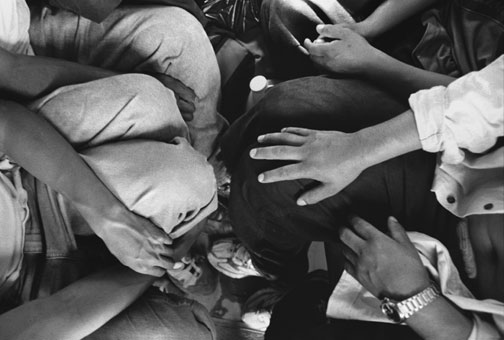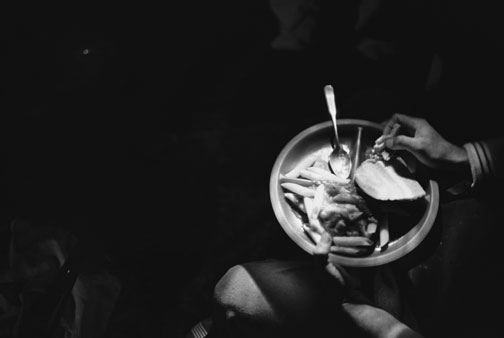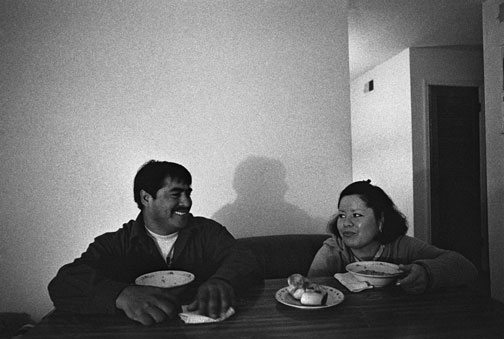Julián Cardona
Curated by Benjamin Alire Sáenz
October 20th – December 3rd, 2005
Opening Reception: Thursday, October 20th, 6-8pm
Born in 1960 in Zacatecas, Mexico, Julián Cardona migrated to the border city of Juarez with his family as a small child. He attended school in Juarez, received vocational training, and worked as a technician in the maquiladora industry. In 1991, Cardona returned to Zacatecas to teach basic photography at the Centro Cultural de Zacatecas; two years later, he started his photojournalism career at El Fronterizo andEl Diario de Juarez. In 1995, Cardona organized the group exhibition, "Nada que ver-Nothing to See," in Juarez, featured in Harper's Magazine (Charles Bowden, "While You Were Sleeping: in Juarez, Mexico, photographers expose the violent realities of free trade) in December 1996. Photographs from this exhibition inspired the award-winning book, Juarez: The Laboratory of Our Future (Aperture, 1998). His photographs taken inside foreign-owned factories in Juarez were also featured in Camera of Dirt(Aperture 159, 2000).
Cardona's work has been exhibited in the Houston FotoFest 98: "Stories About Us;" in "Borders and Beyond," an international group show organized by Pro Helvetia - Arts Council of Switzerland; in "Lines of Sight: Views of the U.S./Mexican Border," at galleries of the University of California at Riverside, Santa Cruz and Merced; and in "Photography Past/Forward: Aperture at 50," at Sotheby's New York in January 2003 and in the Golden- Anniversary publication of the same title. In 2004, Cardona received the Cultural Freedom Fellowship awarded by the Lannan Foundation of Santa Fe, NM.
Benjamin Alire Saenz, poet and novelist, was born in Las Cruces, New Mexico in 1954. His first book of poems, Calendar of Dust, was awarded an American Book Award in 1991. He has subsequently published two other books of poetry, Dark and Perfect Angel, Elegies in Blue and the forthcoming Dreaming the End of War. His works of fiction include Flowers for the Broken, Carry Me Like Water, The House of Forgetting, and Sammy and Juliana in Hollywood. His most recent novel is entitled In Perfect Light published by Rayo/HarperCollins. He is a former Wallace E. Stegner Poetry Fellow at Stanford University and, in addition to the American Book Award, he has won various other awards including a Lannan Poetry Fellowship, a Southwest Book Award, the Paterson Prize, the Americas Book Award, and has been a finalist for the Los Angeles Time Book Prize. He has taught in the M.F.A. program at the University of Texas at El Paso since 1992.
ARTIST'S STATEMENT
A few years after the fall of the Berlin Wall, I found myself in Juarez, Mexico, on one side of the largest border community in the world, a fortunate place to be, and with a camera in my hands. Some were saying that History had ended and announced the arrival of a new Golden Age. Now, more than a decade later, we hear that the world is flat. That day-by-day, people the world over are rising to the next level in the expanding global economy. If that is true, then we need some name for these other things that have broken out since borders opened up for trade and goods and slammed shut to people: child labor, sweatshops, human trafficking, ever- increasing quantities of drugs, explosive violence and endless streams of migrants. The reinvention of slavery.
I make these photographs to show the faces of men and women and children who find their way across these borders to service this economy based on massive consumption. In a flat world, the only frontier left to conquer may be the empty space inside of ourselves, and for some reason, we try to fill that space with goods and entertainments. The millions of migrants who come to do the work also settle this frontier. They are the fathers and mothers of the new Americans. Blood will tell.
CURATOR'S STATEMENT
by Benjamin Alire Saenz
Julian Cardona's photographs are essentially narrative in nature. Though he is obviously having a conversation with modernist and post-modernist aesthetics, his narratives remain steadfastly direct and sincere-though not so direct and sincere as to exclude a sophisticated sense of irony, humor and rage. Well known as a "photojournalist," Cardona is one of those photographers who has managed to escape being labeled an "artist." But "artist" is the exact word that came to my mind when I first encountered his work. His images of Juarez and the border made the familiar seem new-almost surreal, and yet precise. This was no voyeur trying to capture the grotesque. This was no circus. This was a photographer trying to convey what his landscape was like. These were photographs of home.
Cardona's project of bearing witness to a piece of the world that is both despised and romanticized, does not prevent him from sifting through these difficult discourses to get at images that are at once startlingly intimate and yet shamefully public. The stories Cardona is concerned with conveying are impossible and cruel and complicated. Yet he manages to convey these unbearable stories by giving them to us in seemingly uncomplicated images. In looking closely at the vastness of the landscape that lay before him, Cardona has refused to be overwhelmed by it. He has learned the lesson that all poets must learn: it is the image that moves, that speaks, that represents both a literal truth and a metaphorical one. The greatest virtue of Cardona's images is that they convey not only the cruelty of a journey, but its many kindnesses without sentimentalizing or sensationalizing. That virtue is what makes Cardona more than just an ordinary photographer and lifts him into the realm of artist.
View CATALOGUE





